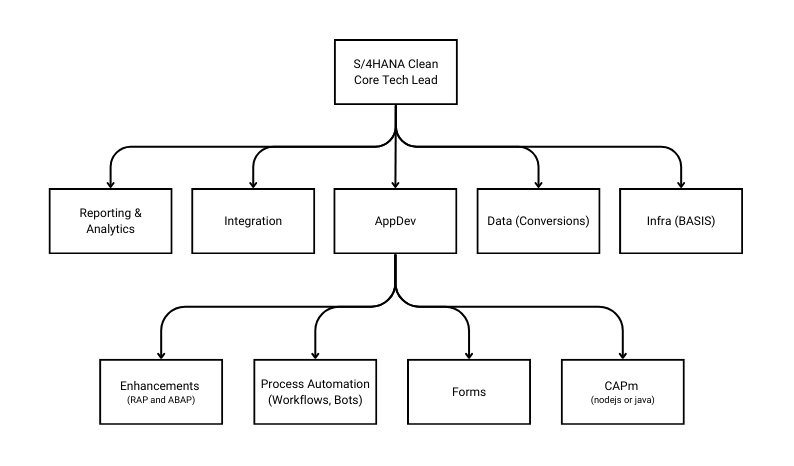Implementing SAP S/4HANA at scale is no small feat. It requires a well-structured tech team that can efficiently manage development, integrations, analytics, data migration, and infrastructure—while ensuring a smooth transition from legacy systems.
Recently, I had the opportunity to lead the Technical team for an S/4HANA RISE implementation where we had to deliver around 600+ RICEFWs (Reports, Interfaces, Conversions, Enhancements, Forms, and Workflows). The complexity of the project reinforced a key lesson: team organization can make or break an implementation.

Here’s a proven tech team structure that balances leadership, specialization, and execution. It comprises of lessons learned from past experiences as well as what could be done in future to improve and create an even better structure.
1. The Tech Lead
At the top of the hierarchy is the Tech Lead, responsible for:
- Defining Clean Core and best practices strategy
- Defining the technical strategy
- Ensuring alignment with business goals and functional workstreams
- Prioritizing work across all tech tracks and PMO
- Addressing cross-team dependencies
- Making critical architectural decisions
This role requires a blend of technical expertise and strong leadership to keep the entire team moving toward the go-live without bottlenecks.
2. Five Core Pillars
Directly reporting to the Tech Lead are five specialized leads, each owning a critical part of the S/4HANA implementation:
1. Reporting & Analytics
- Manages Embedded Analytics, CDS Views, and Fiori Reports
- Owns BW/4HANA integration if applicable
- Ensures operational and strategic reporting needs are met
2. Integration
- Handles SAP BTP Integration Suite, CPI, and APIs
- Manages AIF (Application Interface Framework) for error handling
- Works closely with functional teams to design seamless end-to-end integrations
3. App Development
- Owns all custom development (Enhancements, Workflows, Forms, etc.)
- Divided into three specialized areas (more on this below)
4. Data Conversion
- Oversees data migration from legacy systems to S/4HANA
- Manages ETL (Extract, Transform, Load) processes
- Ensures data validation, cleansing, and cutover readiness
5. Basis & Infrastructure
- Manages landscape setup, clients performance tuning, and security
- DevOps, BTP provisioning, accounts, transport strategy
- Oversees high availability, DR strategy, and system monitoring
- Works closely with the Integration and App Dev teams for deployment strategies
Each of these leads operates independently, but they must collaborate closely to ensure technical alignment across the implementation.
3. App Development Team
Application development in S/4HANA isn’t just about writing ABAP anymore. With SAP pushing Clean Core and extensibility best practices, custom development is now distributed across four key areas:
1. Enhancements (RAP, ABAP, Extensibility)
- Responsible for: Custom objects inside S/4HANA
- Uses RAP (RESTful ABAP Programming Model) for Fiori-based transactional apps
- Implements classic ABAP enhancements (BAdIs, User Exits, Business Events)
2. BPA (Business Process Automation)
- Focuses on SAP Workflow, Process Automation, and RPA
- Works on low-code/no-code automation via SAP BTP
3. Forms (Adobe Forms, SmartForms, Output Management)
- Develops invoices, purchase orders, pay slips, and other structured outputs
- Works on Adobe Forms and SmartForms within the S/4HANA Output Management framework
4. CAPM Development (Cloud Application Programming Model – Node.js/Java)
- Builds side-by-side extensions on SAP BTP
- Uses CAP (Cloud Application Programming Model) with Node.js or Java
- Develops APIs and microservices that extend S/4HANA functionality without modifying the core
This structured approach ensures that custom development is aligned with SAP’s long-term strategy.
4. Why This Structure Works
- Clear ownership – Each team knew exactly what they were responsible for. Similar skill sets are grouped together into smaller teams
- Faster development – Parallel workstreams meant we could build integrations, reports, and enhancements at the same time.
- Fewer conflicts – Having a dedicated Data Conversion team meant we didn’t run into migration issues at the last minute.
- Scalability – With a peak team of 50 people, this structure allowed us to efficiently assign work and move people around without stepping on each other’s toes.
- Future-proofing – By following SAP’s clean core principles, we avoided customizations that would cause problems during future upgrades.
Organizing an S/4HANA implementation tech team is about balancing leadership, specialization, and agility. We saw firsthand how this structure enabled fast delivery, minimized rework, and kept development aligned with SAP’s roadmap.
If you’re leading or structuring a team for an S/4HANA project, contact us today to learn how my team and I can help you to support you S/4HANA transformation.
